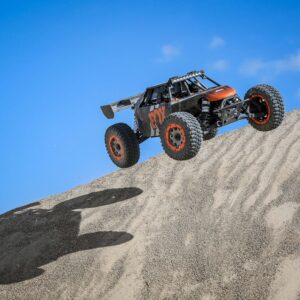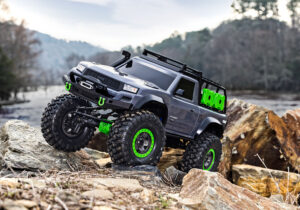Polycarbonate is a popular material used for the bodies of remote-controlled (RC) cars and trucks. It is lightweight, durable, and flexible, making it well-suited for RC applications. Polycarbonate bodies come clear or pre-painted from the manufacturer. However, there are a few reasons why the original paint may need to be removed by the RC hobbyist.
Firstly, the pre-applied paint jobs are often basic in style and color. RC enthusiasts may want to customize their vehicles with more unique and stylish paint schemes. Removing the original paint allows for repainting the body. Secondly, the factory paint can become scratched, chipped or faded over time with use. This deteriorated paint detracts from the appearance of the RC body. Stripping the body gives it a fresh start for repainting. Lastly, used RC vehicles are commonly purchased second-hand. In some cases, the previous owner’s paint job is no longer desirable. The new owner will want to remove this paint and re-paint the body to their own taste.
In all cases, the polycarbonate material allows the paint to be safely removed and the body to be refinished multiple times. This makes polycarbonate a very reusable and customizable material for RC car and truck bodies.
1. Preparation

Proper supplies and set-up are key to safely and effectively removing paint from a polycarbonate RC body. This preparation is broken down into gathering the necessary tools and materials, as well as establishing a suitable workspace.
The key tools and materials needed are chemical paint removers and solvents, rags and abrasives. Recommended chemicals include acetone, isopropyl alcohol, and commercial paint strippers. These will dissolve and loosen the layers of paint on the RC body. An assortment of clean rags is useful for applying the chemicals. Abrasives such as sandpaper, steel wool, or a plastic scrub pad help to mechanically scrub off paint if needed. Safety gear like gloves and eye protection should be used when handling chemicals.
The workspace should be an outdoor area or garage with ample ventilation. Chemical fumes from paint stripping can be strong, so working in a ventilated area lessens exposure. The area should also have a surface that can withstand spills and drips of remover chemicals. Protecting the floor with a drop cloth is advisable. Have all supplies and tools gathered in the workspace before starting. Also clear the area of any flammable materials due to the combustible nature of some chemical removers. Taking these preparations makes the paint removal process safer and more organized.
2. Removal Steps

With proper supplies and workspace set up, the paint can now be stripped from the polycarbonate RC body using a systematic process. This involves using chemical solvents, physical abrasion, and inspection to completely remove the paint down to the clear body material.
The first step is to wipe down the entire painted surface with rags soaked in acetone. Acetone will dissolve and break down the layers of paint, causing it to soften and lose adhesion. Wiping gently with the acetone rags will make the paint start to flake off. Areas with thicker paint buildup may require more concentrated wiping or even lightly scrubbing with an abrasive pad.
For paint that remains stubbornly stuck on after the acetone wipe down, use sandpaper or steel wool to further abrade the surface. Lightly sanding across the body will grind off the top paint layer. This is especially effective on paint that has formed a hardened shell. Be careful when sanding not to grind into the plastic body.
Once the paint is removed in an area, wipe it down with isopropyl alcohol. The alcohol helps dissolve any remaining paint residue and also cleans the stripped section of body. Thoroughly wiping each section with alcohol is key to fully prepping the bare plastic surface.
It is important to closely inspect the entire body to check for any remnants of old paint. Any specks or film of leftover paint must be removed, so repeat the wiping and sanding steps anywhere paint still persists. Only a completely clean body is ready for repainting, so take the time to remove 100% of the original paint.
3. Body Protection

Once the original paint is fully removed from the polycarbonate RC body, an important next step is applying a protective coating to the bare plastic material. Without protection, the exposed body is susceptible to environmental damage from sunlight, dirt and chemical exposure over time.
A polycarbonate-compatible sealant or wax should be lightly buffed into the stripped body using a clean, soft cloth. Common options are carnauba wax, acrylic sealant, or dedicated RC car body protector sprays. The protector provides a transparent buffer layer on the surface that resists corrosion, fading, and accumulation of grime. It fills in micro-scratches and creates a smooth prepped surface for repainting as well.
Be sure to apply the protector sparingly as excessive buildup can interfere with paint adhesion later. Work it thoroughly into the body’s contours to cover evenly. In addition to preventing damage in the interim before repainting, this layer of protection will prolong the life of the new paint job. A well-preserved plastic body maintains its clarity and luster even after repeated repainting. With a bit of care, a quality polycarbonate shell can look great for many seasons of RC use.
FAQs about removing paint from polycarbonate RC bodies
What types of chemicals can be used to remove paint from a polycarbonate RC body?
There are a few common chemical options that are effective at dissolving and stripping paint from polycarbonate plastic. These include acetone, denatured alcohol, xylene, and commercial paint strippers containing methylene chloride. Acetone works especially well to quickly soften most paints for removal. Be sure to select a chemical that is compatible with polycarbonate so it doesn’t damage the plastic.
What tools help get the paint off faster?
Using an abrasive tool in conjunction with chemical strippers can speed up the paint removal process. Sandpaper, steel wool, or a plastic scrub pad can mechanically scrub off the softened paint layers. Start with a fine grit sandpaper and use a scrubbing motion to wear through the paint. Be careful not to gouge the plastic body when sanding.
How can I protect my hands/face from the harsh chemicals?
Wearing gloves and safety goggles is highly recommended when handling paint stripping chemicals. Opt for thick rubber gloves rather than standard latex. A respirator mask is also a good idea if working in an enclosed area. Be sure to work in a well-ventilated area. Take care not to splash or drip chemicals onto your skin or into your eyes.
What is the best way to prep the body for new paint after stripping the old paint?
After getting all the paint off, wash the stripped body with soap and water. Once fully dried, lightly sand the plastic with fine (400+ grit) sandpaper to rough up the surface and provide “tooth” for the new paint. Wipe it down with a tack cloth to remove any residue before applying primer and new paint.
How can I avoid paint bleeding when repainting the body?
Not properly prepping the stripped body can lead to bubbling or bleeding of the new paint. Make sure to remove any remaining paint residue, oils, or polish compounds so the new paint can directly bond to the bare plastic. Use a plastic-adhesion promoting primer before painting. Apply paint in thin, even coats allowing proper drying time between coats.
Is there a way to remove the paint without chemicals?
For very light paint jobs, you may be able to carefully peel it off using a plastic paint scraping tool. However, chemical strippers are typically required to break down thicker, baked-on paint down to the bare plastic. Wet sanding with fine paper can also slowly wear off paint but tends to be labour intensive compared to chemical stripping.
Final Thoughts
Removing paint from an RC polycarbonate body can breathe new life into a used model or allow for custom paint jobs. With the right supplies and techniques, the original paint can be safely stripped away to reveal the pristine plastic surface underneath. While chemical removers do the heavy work of dissolving the layers of paint, some elbow grease is also needed to scrub and sand away stubborn remnants.
Being meticulous about getting all the paint off is crucial before moving on to re-painting. Taking steps to properly prepare and protect the bare body will lead to a smooth, long-lasting paint job. Polycarbonate is a very forgiving material, so don’t be intimidated to strip and repaint your body as often as you like. With a little patience, you can transform even an old, painted-over RC shell into a stunning, factory-fresh work of art.
Enjoyed this guide of how to remove paint from polycarbonate RC body? Then be sure to check out our other RC Rating guides.